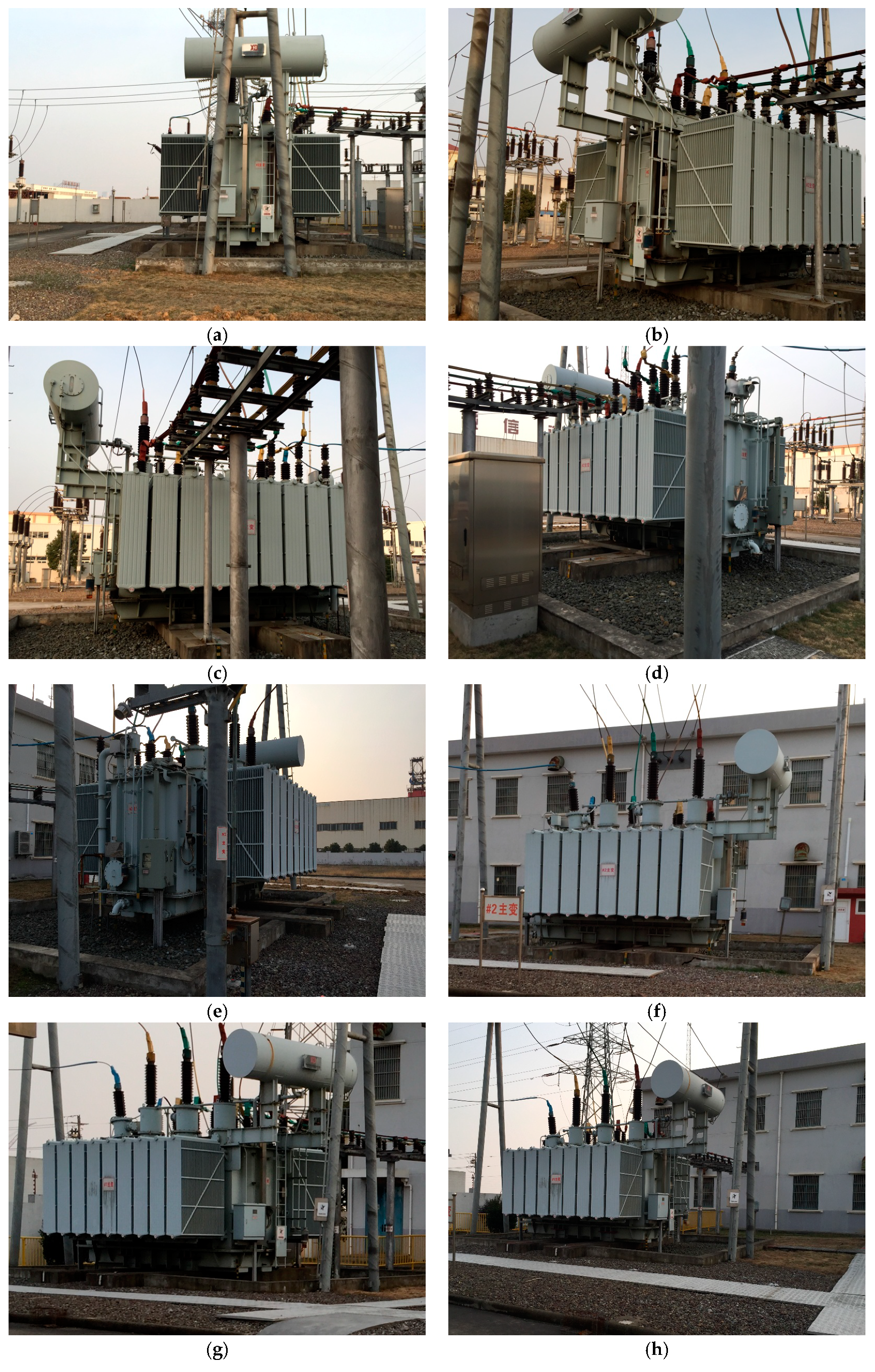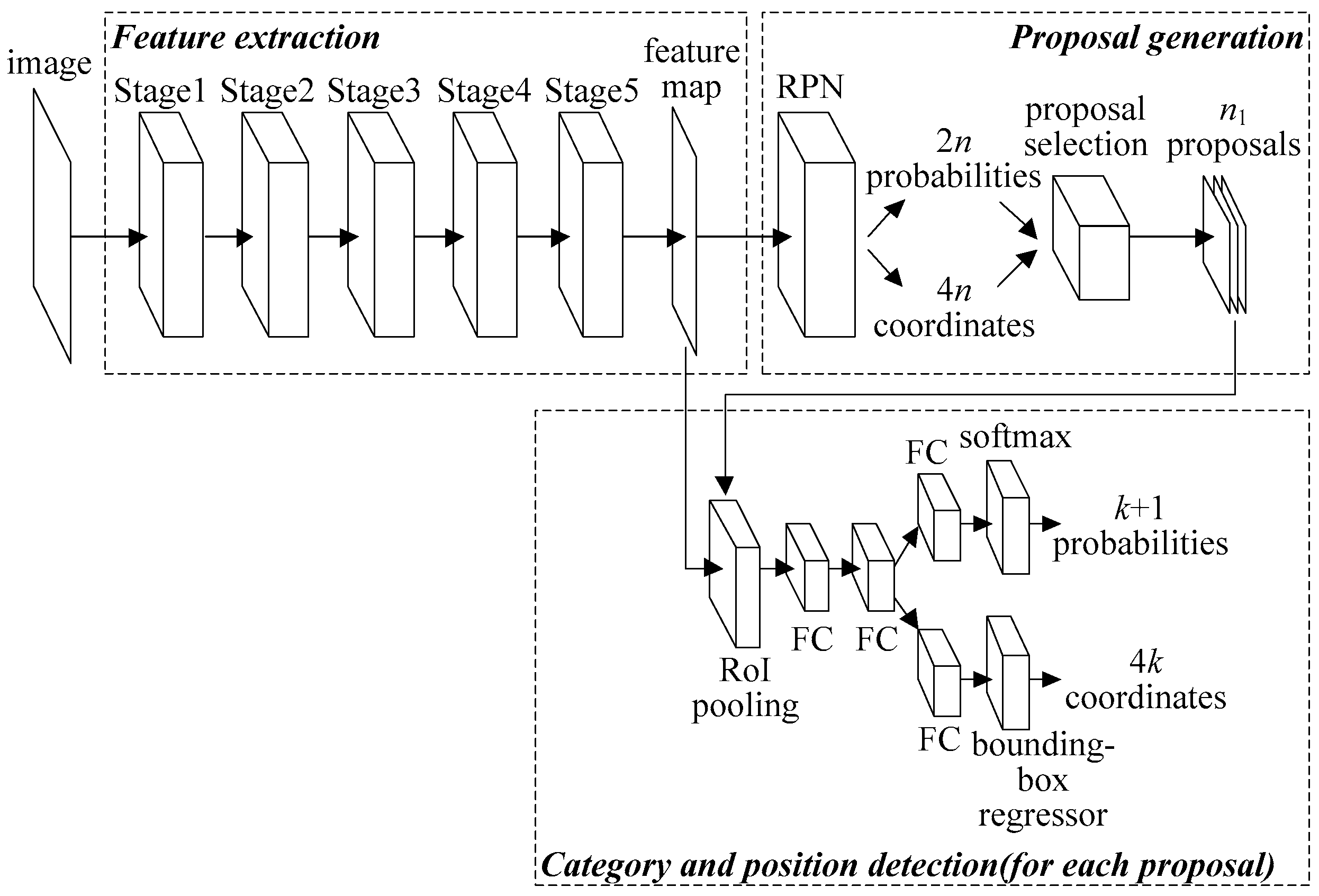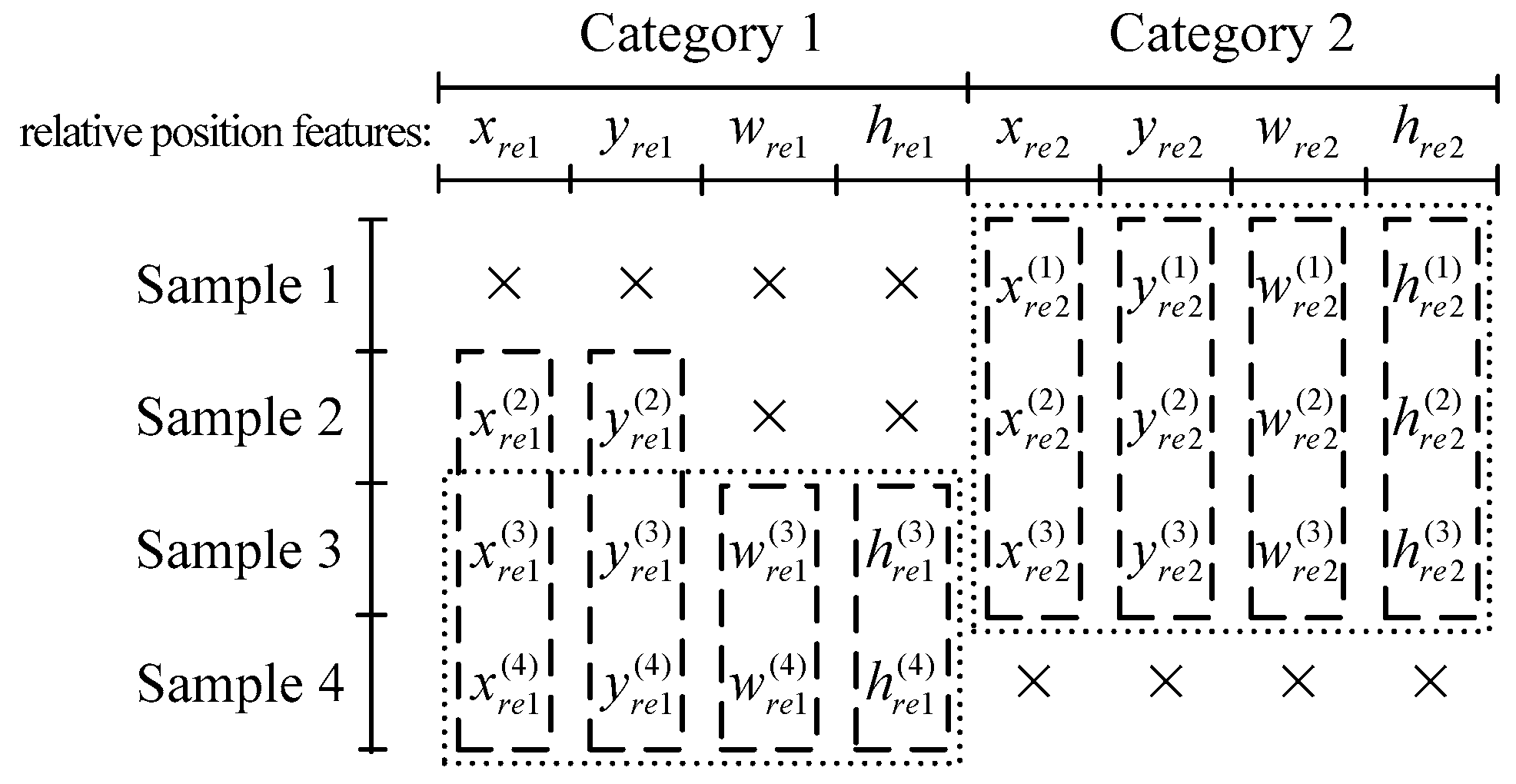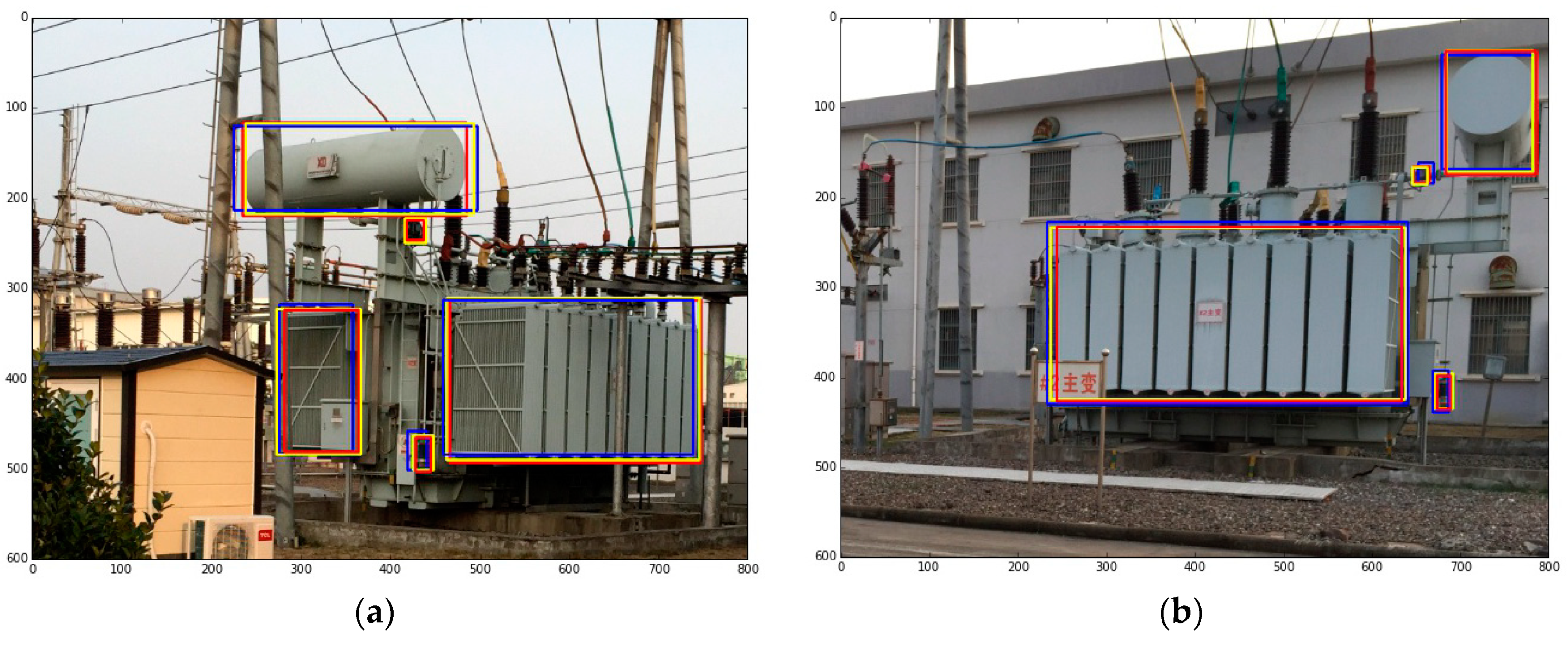Automatic Detection of Transformer Components in Inspection Images Based on Improved Faster R-CNN
Abstract
:1. Introduction
2. Related Work
3. Improved Faster R-CNN for Transformer Component Detection
3.1. Architecture of Improved Faster R-CNN
3.2. Double Feature Maps for Different Component Sizes
3.3. Relative Position Features of Components
3.4. Random Forests for Refining Probabilities and Coordinates
4. Training and Detection Process
4.1. Training Process of Improved Faster R-CNN
4.2. Detection Process of Improved Faster R-CNN
| Algorithm 1. Algorithm for transformer component detection |
| Input: an image, n1*, confidence_threshold* Output: a set final_boxes* containing k1 final box tuples (k1 = 0, 1, …, k), each of which contains a component category with a probability and 4 coordinates Input an image to ResNet-50 and generate feature map 1 and feature map 2 Initialize final_boxes to empty set While the number of elements in final_boxes < k do Input feature map 1 to proposal generation module* and generate n1 proposals Input n1 proposals, feature map 1 and feature map 2 to category and position detection module* and generate n1 × k box tuples (ignore the background category), each of which contains a category with a probability and 4 coordinates, and form a set boxes with n1 × k box tuples Delete all the box tuples whose categories already exist in final_boxes from boxes Select the box tuple with the highest probability in boxes as final_box If the probability of final_box < confidence_threshold then Break Else Append final_box to final_boxes End if End while |
- The parameter n1 decides the number of the proposals selected into the category and position detection module; the parameter confidence_threshold decides the probability threshold of the output final box.
- Each final box in the set final_boxes frames a detected transformer component in the image, and provides its category and probability.
- The relative position features of a proposal in the proposal generation module or the category and position detection module are generated by the coordinates of the proposal and the final boxes.
5. Case Study
5.1. Data Set, Models and Indices
5.2. Detection Results and Discussion
5.2.1. Double Feature Maps
5.2.2. Relative Position Features
6. Conclusions
Author Contributions
Funding
Conflicts of Interest
Appendix A

References
- Chen, H.; Zhao, X.; Zhao, X.; Tan, M. Computer vision-based detection and state recognition for disconnecting switch in substation automation. Int. J. Robot. Autom. 2017, 32, 1–12. [Google Scholar] [CrossRef]
- Yan, B.; Chen, H.; Huang, W. Study on the method of switch state detection based on image recognition in substation sequence control. In Proceedings of the 2014 International Conference on Power System Technology (POWERCON 2014), Chengdu, China, 20–22 October 2014; pp. 2504–2510. [Google Scholar] [CrossRef]
- Sun, L. Research on Practical Image Recognition Method of Abnormal Phenomenon of Electric Equipments in Substation. Master’s Thesis, North China Electric Power University, Beijing, China, March 2015. [Google Scholar]
- Bharata Reddy, M.J.; Chandra, B.K.; Mohanta, D.K. A DOST based approach for the condition monitoring of 11 kV distribution line insulators. IEEE Trans. Dielectr. Electr. Insul. 2011, 18, 588–595. [Google Scholar] [CrossRef]
- Wang, T.; Yao, C.; Liu, J.; Chao, L.; Shao, G.; Qun, H.; Ming, Y. Research on automatic identification of substation circuit breaker based on shape priors. Appl. Mech. Mater. 2014, 511–512, 923–926. [Google Scholar] [CrossRef]
- Lowe, D.G. Distinctive image features from scale-invariant keypoints. Int. J. Comput. Vis. 2004, 60, 91–110. [Google Scholar] [CrossRef]
- Dalal, N.; Triggs, B. Histograms of oriented gradients for human detection. In Proceedings of the IEEE Computer Society Conference on Computer Vision and Pattern Recognition, San Diego, CA, USA, 20–25 June 2005; pp. 886–893. [Google Scholar] [CrossRef]
- Shao, J.; Yan, Y.; Qi, D. Substation switch detection and state recognition based on Hough forests. Autom. Electr. Power Syst. 2016, 40, 115–120. [Google Scholar] [CrossRef]
- Girshick, R.; Donahue, J.; Darrell, T.; Malik, J. Rich feature hierarchies for accurate object detection and semantic segmentation. In Proceedings of the IEEE Conference on Computer Vision and Pattern Recognition, Columbus, OH, USA, 24–27 June 2014; pp. 580–587. [Google Scholar] [CrossRef]
- Girshick, R. Fast R-CNN. In Proceedings of the IEEE International Conference on Computer Vision, Santiago, Chile, 13–16 December 2015; pp. 1440–1448. [Google Scholar] [CrossRef]
- Ren, S.; He, K.; Girshick, R.; Sun, J. Faster R-CNN: Towards real-time object detection with region proposal networks. IEEE Trans. Pattern Anal. Mach. Intell. 2017, 39, 1137–1149. [Google Scholar] [CrossRef]
- Liu, W.; Anguelov, D.; Erhan, D.; Szegedy, C.; Reed, S.; Fu, C.; Berg, A.C. SSD: Single shot multibox detector. In Proceedings of the European Conference on Computer Vision, Amsteram, The Netherlands, 11–14 October 2016; pp. 21–37. [Google Scholar] [CrossRef]
- Dai, J.; Li, Y.; He, K.; Sun, J. R-FCN: Object detection via region-based fully convolutional networks. In Proceedings of the 30th Conference on Neural Information Processing Systems (NIPS 2016), Barcelona, Spain, 5–10 December 2016; pp. 379–387. [Google Scholar]
- Lin, T.Y.; Dollar, P.; Girshick, R.; He, K.; Hariharan, B.; Belongie, S. Feature pyramid networks for object detection. In Proceedings of the IEEE Conference on Computer Vision and Pattern Recognition, Honolulu, HI, USA, 21–26 July 2017; pp. 936–944. [Google Scholar] [CrossRef]
- Zhou, Q.; Zhao, Z. Substation equipment image recognition based on SIFT feature matching. In Proceedings of the 2012 5th International Congress on Image and Signal Processing (CISP 2012), Chongqing, China, 16–18 October 2012; pp. 1344–1347. [Google Scholar] [CrossRef]
- Chen, A.; Le, Q.; Zhang, Z.; Sun, Y. An image recognition method of substation breakers state based on robot. Autom. Electr. Power Syst. 2012, 36, 101–105. [Google Scholar]
- Chen, H.; Sun, S.; Wang, T.; Zhao, X.; Tan, M. Automatic busbar detection in substation: Using directional Gaussian filter, gradient density, Hough transform and adaptive dynamic K-means clustering. In Proceedings of the 34th Chinese Control Conference, Hangzhou, China, 28–30 July 2015; pp. 4668–4672. [Google Scholar] [CrossRef]
- Wang, J.; Wang, J.; Shao, J.; Li, J. Image recognition of icing thickness on power transmission lines based on a least squares Hough transform. Energies 2017, 10, 415. [Google Scholar] [CrossRef]
- Li, Z.; Liu, Y.; Walker, R.; Hayward, R.; Zhang, J. Towards automatic power line detection for UAV surveillance system using pulse coupled neural filter and Hough transform. Mach. Vis. Appl. 2010, 21, 677–686. [Google Scholar] [CrossRef]
- Zhao, Z.; Zhang, L.; Qi, Y.; Shi, Y. A generation method of insulator region proposals based on edge boxes. Optoelectron. Lett. 2017, 13, 466–470. [Google Scholar] [CrossRef]
- Sermanet, P.; Eigen, D.; Zhang, X.; Mathieu, M.; Fergus, R.; Lecun, Y. Overfeat: Integrated recognition, localization and detection using convolutional networks. In Proceedings of the International Conference on Learning Representations, Banff, AB, Canada, 14–16 April 2014; pp. 1–16. [Google Scholar] [CrossRef]
- Bell, S.; Zitnick, C.L.; Bala, K.; Girshick, R. Inside-Outside Net: Detecting objects in context with skip pooling and recurrent neural networks. In Proceedings of the IEEE Conference on Computer Vision and Pattern Recognition, Las Vegas, NV, USA, 27–30 June 2016; pp. 2874–2883. [Google Scholar] [CrossRef]
- Kong, T.; Yao, A.; Chen, Y.; Sun, F. Hypernet: Towards accurate region proposal generation and joint object detection. In Proceedings of the IEEE Conference on Computer Vision and Pattern Recognition, Las Vegas, NV, USA, 27–30 June 2016; pp. 845–853. [Google Scholar] [CrossRef]
- Wang, X.; Ma, H.; Chen, X.; You, S. Edge preserving and multi-scale contextual neural network for salient object detection. IEEE Trans. Image Process. 2018, 27, 121–134. [Google Scholar] [CrossRef]
- Redmon, J.; Farhadi, A. YOLOv3: An Incremental Improvement. Available online: https://pjreddie.com/media/files/papers/YOLOv3.pdf (accessed on 1 November 2018).
- Redmon, J.; Divvala, S.; Girshick, R.; Farhadi, A. You only look once: Unified, real-time object detection. In Proceedings of the IEEE Conference on Computer Vision and Pattern Recognition, Las Vegas, NV, USA, 27–30 June 2016; pp. 779–788. [Google Scholar] [CrossRef]
- Zhou, P.; Ni, B.; Geng, C.; Hu, J.; Xu, Y. Scale-transferrable object detection. In Proceedings of the IEEE Conference on Computer Vision and Pattern Recognition, Salt Lake City, UT, USA, 19–21 June 2018; pp. 528–537. [Google Scholar]
- Cai, Z.; Vasconcelos, N. Cascade R-CNN: Delving into high quality object detection. In Proceedings of the IEEE Conference on Computer Vision and Pattern Recognition, Salt Lake City, UT, USA, 19–21 June 2018. [Google Scholar]
- Cheng, B.; Wei, Y.; Shi, H.; Feris, R.; Xiong, J.; Huang, T. Revisiting RCNN: On awakening the classication power of Faster RCNN. In Proceedings of the European Conference on Computer Vision, Munich, Germany, 8–14 September 2018. [Google Scholar]
- Jiang, B.; Luo, R.; Mao, J.; Xiao, T.; Jiang, Y. Acquisition of localization confidence for accurate object detection. In Proceedings of the European Conference on Computer Vision, Munich, Germany, 8–14 September 2018. [Google Scholar]
- Chen, Y.; Li, W.; Sakaridis, C.; Dai, D.; Gool, L.V. Domain adaptive Faster R-CNN for object detection in the wild. In Proceedings of the IEEE Conference on Computer Vision and Pattern Recognition, Salt Lake City, UT, USA, 19–21 June 2018. [Google Scholar]
- Liu, S.; Huang, D.; Wang, Y. Receptive Field Block Net for accurate and fast object detection. In Proceedings of the European Conference on Computer Vision, Munich, Germany, 8–14 September 2018. [Google Scholar]
- Szegedy, C.; Ioffe, S.; Vanhoucke, V.; Alemi, A.A. Inception-v4, Inception-ResNet and the impact of residual connections on learning. In Proceedings of the Thirty-First AAAI Conference on Artificial Intelligence, San Francisco, CA, USA, 4–10 February 2017; pp. 4278–4284. [Google Scholar]
- He, K.; Zhang, X.; Ren, S.; Sun, J. Deep residual learning for image recognition. In Proceedings of the IEEE Conference on Computer Vision and Pattern Recognition, Las Vegas, CA, USA, 27–30 June 2016; pp. 770–778. [Google Scholar] [CrossRef]
- Russell, S.J.; Norvig, P. Making simple decisions. In Artificial Intelligence: A Modern Approach, 2nd ed.; Pompili, M., Chavez, S., Eds.; Alan Apt: Englewood Cliffs, NJ, USA, 2003; Volume 5, pp. 471–497. ISBN 0-13-103805-2. [Google Scholar]
- Breiman, L.; Friedman, J.H.; Olshen, R.A.; Stone, C.J. Classification and Regression Trees; CRC Press: Boca Raton, FL, USA, 1998; ISBN 0-412-04841-8. [Google Scholar]
- Quinlan, J.R. C4.5: Programs for Machine Learning; Morgan Kaufmann Publishers: San Mateo, CA, USA, 1993; ISBN 1-55860-238-0. [Google Scholar]
- Brodley, C.E.; Utgoff, P.E. Multivariate decision trees. Mach. Learn. 1995, 19, 45–77. [Google Scholar] [CrossRef]
- Russakovsky, O.; Deng, J.; Su, H.; Krause, J.; Satheesh, S.; Ma, S.; Huang, Z.; Karpathy, A.; Khosla, A.; Bernstein, M.; et al. ImageNet large scale visual recognition challenge. Int. J. Comput. Vis. 2015, 115, 211–252. [Google Scholar] [CrossRef]









| Step | Training Task | Corresponding Arrow in Figure 5 |
|---|---|---|
| 1 | Initialize ResNet-50, and train from Stage 1 to RPN. | Red arrow |
| 2 | Reinitialize Stage 1 and 2, and train from Stage 1 to softmax/bounding-box regressor in feature map 2 branch using the proposals selected from the ones generated by RPN in Step 1. | Orange arrow |
| 3 | Fix Stage 1 and 2, reinitialize Stage 3 to 5, and train from Stage 3 to softmax/bounding-box regressor in feature map 1 branch using the same proposals in Step 2. | Yellow arrow |
| 4 | Fix ResNet-50, and fine-tune RPN. | Green arrow |
| 5 | Fix ResNet-50, and fine-tune from RoI pooling to softmax/bounding-box regressor in feature map 2 branch using the proposals selected from the ones generated by RPN in Step 4. | Blue arrow |
| 6 | Fix ResNet-50, and fine-tune from RoI pooling to softmax/bounding-box regressor in feature map 1 branch using the same proposals in Step 5. | Purple arrow |
| Statistical Amount | Data Set | |
|---|---|---|
| Amount of the images containing c component categories | c = 1 | 0 |
| c = 2 | 204 | |
| c = 3 | 593 | |
| c = 4 | 777 | |
| c = 5 | 426 | |
| c = 6 | 0 | |
| Amount of the images containing each component category | Conservator | 1792 |
| #1–#9 radiator group 1 | 1458 | |
| #10–#18 radiator group 1 | 1574 | |
| Gas relay | 1200 | |
| Breather of main body | 681 | |
| Breather of OLTC | 720 | |
| Parameter | RF Classifier | RF Regressor |
|---|---|---|
| Number of decision trees | 100 | 30 |
| Maximum depth of a tree | 50 | 50 |
| Minimum samples for splitting | 5 | 6 |
| Minimum samples in a leaf node | 4 | 4 |
| Model | Feature Map(s) | With Relative Position Features? |
|---|---|---|
| FRCNN-improved | Double | Yes |
| FRCNN-v1 | Single | Yes |
| FRCNN-v2 | Double | No |
| FRCNN-original | Single | No |
| Index | FRCNN-Improved | FRCNN-v1 | FRCNN-v2 | FRCNN-Original | Cascade R-CNN | YOLOv3 | SSD | R-FCN | |
|---|---|---|---|---|---|---|---|---|---|
| mAP (%) | 95.3 | 91.9 | 86.4 | 83.8 | 88.5 | 77.8 | 78.0 | 79.0 | |
| Conservator | P (%) | 98.5 | 98.4 | 95.6 | 95.1 | 98.1 | 90.8 | 94.2 | 94.0 |
| R (%) | 97.4 | 97.0 | 93.9 | 93.1 | 96.4 | 87.3 | 92.7 | 92.9 | |
| #1–#9 radiator group | P (%) | 96.7 | 94.7 | 86.9 | 85.6 | 88.6 | 82.1 | 85.4 | 84.1 |
| R (%) | 96.4 | 93.7 | 81.3 | 82.6 | 85.1 | 80.5 | 83.1 | 80.0 | |
| #10–#18 radiator group | P (%) | 96.7 | 94.4 | 84.8 | 83.1 | 86.4 | 81.2 | 83.7 | 82.5 |
| R (%) | 95.9 | 92.8 | 80.9 | 80.5 | 84.3 | 78.0 | 81.0 | 79.9 | |
| Gas relay | P (%) | 86.3 | 78.3 | 80.7 | 69.6 | 82.2 | 68.6 | 65.3 | 68.4 |
| R (%) | 87.5 | 73.6 | 78.8 | 66.8 | 79.9 | 64.9 | 61.3 | 65.1 | |
| Breather of main body | P (%) | 92.7 | 86.2 | 74.9 | 71.4 | 75.4 | 72.1 | 69.7 | 70.6 |
| R (%) | 92.7 | 86.8 | 79.3 | 74.9 | 78.1 | 75.6 | 72.2 | 74.2 | |
| Breather of OLTC | P (%) | 88.6 | 81.2 | 72.5 | 62.9 | 74.2 | 64.8 | 57.8 | 62.6 |
| R (%) | 90.7 | 85.7 | 71.9 | 63.2 | 74.6 | 64.4 | 60.6 | 61.5 | |
| Total | P (%) | 94.3 | 90.8 | 85.0 | 81.2 | 86.7 | 79.2 | 80.1 | 80.3 |
| R (%) | 94.2 | 89.7 | 82.7 | 79.5 | 85.2 | 77.1 | 77.9 | 78.4 | |
| t(s) | 2.1 | 1.6 | 1.3 | 1.1 | 1.5 | 0.2 | 0.4 | 0.9 | |
© 2018 by the authors. Licensee MDPI, Basel, Switzerland. This article is an open access article distributed under the terms and conditions of the Creative Commons Attribution (CC BY) license (http://creativecommons.org/licenses/by/4.0/).
Share and Cite
Liu, Z.; Wang, H. Automatic Detection of Transformer Components in Inspection Images Based on Improved Faster R-CNN. Energies 2018, 11, 3496. https://doi.org/10.3390/en11123496
Liu Z, Wang H. Automatic Detection of Transformer Components in Inspection Images Based on Improved Faster R-CNN. Energies. 2018; 11(12):3496. https://doi.org/10.3390/en11123496
Chicago/Turabian StyleLiu, Ziquan, and Huifang Wang. 2018. "Automatic Detection of Transformer Components in Inspection Images Based on Improved Faster R-CNN" Energies 11, no. 12: 3496. https://doi.org/10.3390/en11123496
APA StyleLiu, Z., & Wang, H. (2018). Automatic Detection of Transformer Components in Inspection Images Based on Improved Faster R-CNN. Energies, 11(12), 3496. https://doi.org/10.3390/en11123496




